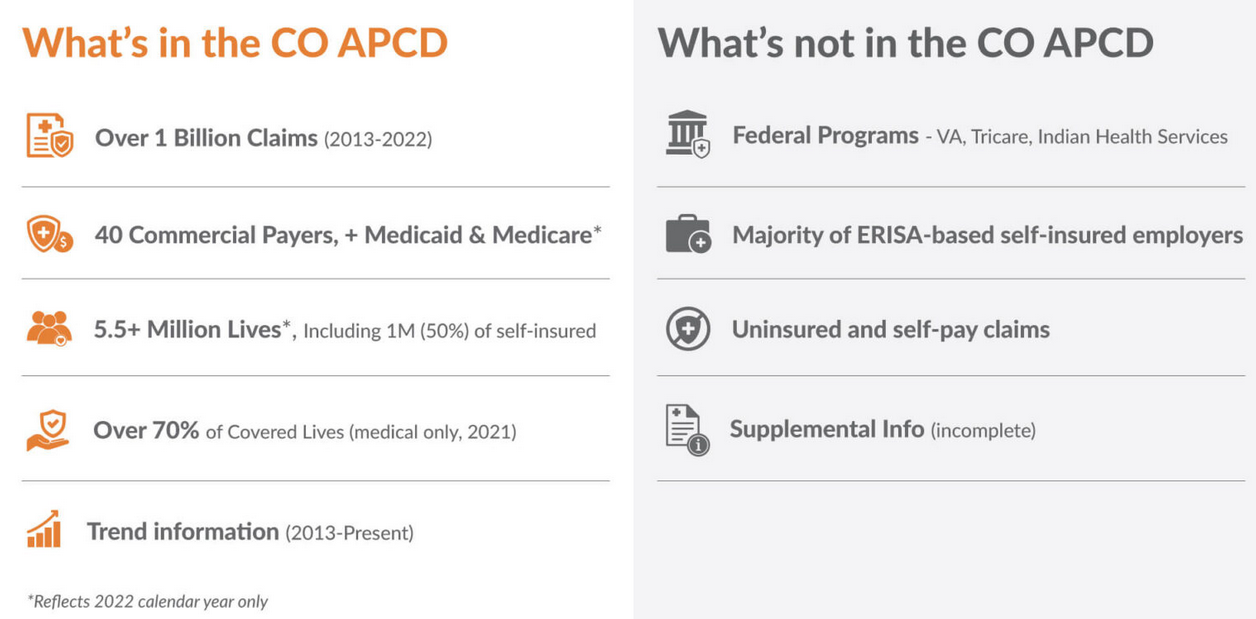A previous query defined the different nuances encompassed under the term “data quality” to help shed light on the myriad factors that can impact the contents of an output from the Colorado All Payer Claims Database (CO APCD). This piece will outline some baseline expectations for users who are new to claims data.
Claims Data is Administrative Data
When the purpose of a health care claim is considered, it becomes clear what kind of data it will contain – it is chiefly designed for provider reimbursement, so all information will be related to the services rendered and the associated payments or costs. Since certain things are not required for billing, like height, weight, blood pressure, or test results, they are not included in a claim. Diagnoses, procedures or treatments, and length of visit are included because insurance companies use the information to process (or adjudicate) claims and determine who should be paid, and for what amount.
Here is a breakdown of what information is submitted to the CO APCD by claim type (medical, professional, pharmacy, or dental).

Claims data in the CO APCD will always be retrospective. By its nature, claims data cannot be released in real time because of the process it goes through:
- Patient visits provider
- Provider (or their staff/service) codes and submits the claim
- Health insurance company processes the claim (note, this process can be lengthy and not all claims are paid initially and some are denied)
- If the claim is processed (adjudicated), it is submitted to the CO APCD
- CIVHC data managers HSRI & NORC receive the claim, and ensure it is submitted correctly, and passes numerous validity/quality checks
- If the claim passes CIVHC intake, it makes it to the CO APCD data warehouse
The time between the patient visit and the claim’s incorporation into the CO APCD can be as short as three months or it can take longer based on a hold up at any of the steps listed above.
CIVHC maintains a process to regularly update the CO APCD warehouse. Payers provide CIVHC with data monthly, and every two months we incorporate that data in a data warehouse refresh and re-process the entire CO APCD to fix or correct irregularities that may have existed with previous submissions. This ensures all data in the CO APD is consistent and processed using the same rules.
CIVHC regularly posts information about what months have been added to the CO APCD following each refresh on the Data User Resources page on civhc.org.
What Can You Do with Claims Data?
By considering the information included in a claim, it is possible to start to see what type of analyses are possible with an APCD. Some of the big bucket examples are:
- Since they are predominately for billing/payment, an obvious choice is investigating costs. Of particular value, a claim enables users to understand not only what was charged by providers and facilities, but what was actually paid by the insurance company and patient.
- With the type of facilities and services/treatments listed, it is possible to study utilization to understand where people are going for different services (and how cost varies by location)
- Chronic conditions can be explored given the indication of diagnosis.
- Health care use and access can also be investigated since the claim indicates that a visit took place and has age and gender included to dive deeper into whether certain populations are receiving care as recommended.
- Quality of care is also possible to evaluate since the types of tests and services are listed with the diagnosis, and there are specific guidelines on what should be done for certain conditions.
The combination of the data elements in a claim can lead to nearly infinite topics of study and it can become daunting to try to narrow down a project to something manageable. There are also multiple nuances about what is possible with the CO APCD. CIVHC has some resources available to help navigate the possibilities of using CO APCD data. The Change Agent Index is a sortable list of projects using CO APCD data to improve lives in Colorado and across the country. Additionally, CIVHC hosted a webinar discussing use cases of the CO APCD and how Change Agents have utilized the database to make decisions to improve lives in Colorado and across the country.
If you have questions about a potential project using CO APCD claims data, please contact us at info@civhc.org.